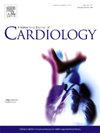怀疑血管迷走神经性晕厥患者的平视倾斜试验:meta回归模型。
IF 3.2
2区 医学
Q2 CARDIAC & CARDIOVASCULAR SYSTEMS
引用次数: 0
摘要
背景:平视倾斜试验(HUT)是诊断疑似反射性晕厥的有效工具。我们进行了meta回归分析来评估年龄和工具参数对HUT结果的影响。方法:在多个数据库中检索,截至2024年7月,纳入了至少100名有晕厥史的患者或50名无(对照组)接受被动HUT(60或70度)最终用异丙肾上腺素或硝酸甘油增强的研究,共97篇文章。结果:无药HUT患者总阳性率为34 %(95% %可信区间:29 ~ 39 %),异丙肾上腺素组患者总阳性率为53 %(45 ~ 60 %),硝酸甘油组患者总阳性率为62 %(59 ~ 66 %)。对照组876例无药HUT总阴性率为85 %(80 ~ 90 %),331例异丙肾上腺素组总阴性率83 %(76 ~ 90 %),806例硝酸甘油组总阴性率88 %(83 ~ 94 %)。在患者中,较高的HUT阳性率与被动期和总体年龄的年轻有关,并且与药理学刺激有关,在活跃期,硝酸甘油的诊断率明显高于异丙肾上腺素。较长的被动期增加了未用药期晕厥的发生率,但减少了主动用药期晕厥的发生率。结论:在临床应用的HUT中,患者的年龄和方法对倾斜角度的影响不如患者的年龄和方法重要,在较短的方案中需要药物刺激来提高阳性率。HUT的诊断作用随着年龄的增长而改变,在是否使用硝酸甘油增强的老年患者中更为重要。本文章由计算机程序翻译,如有差异,请以英文原文为准。

Head-up tilt testing in patients with suspected vasovagal syncope: A meta-regression modelling
Background
Head-up tilt testing (HUT) is a useful diagnostic tool for patients with suspected reflex syncope. We conducted a meta-regression analysis to evaluate the influence of age and instrumental parameters on HUT outcome.
Methods
Searching in multiple databases, 97 articles were identified until July 2024 among studies enrolling at least 100 patients with history of syncope or 50 subjects without (controls) who underwent to passive HUT (60 or 70 degree) eventually potentiated with isoproterenol or nitroglycerin.
Results
The pooled positivity rate of patients was 34 % (95 % confidence interval: 29–39 %) in 8362 drug-free HUT, 53 % (45–60 %) in 2121 with isoproterenol and 62 % (59–66 %) in 14,054 with nitroglycerin. The pooled negativity rate of controls was 86 % (81–91 %) in 876 drug-free HUT, 83 % (76–91 %) in 276 with isoproterenol and 88 % (83–94 %) in 806 with nitroglycerin. In patients, a greater HUT positivity rate was associate to younger age for the passive stage and overall, and to pharmacological provocation that showed, during the active phase, a significant higher diagnostic yield of nitroglycerin than isoproterenol. A longer duration of passive stage increased the rate of syncope during the unmedicated phase but reduced probability during the active one. In controls, older age was associated to a greater proportion of negative response.
Conclusions
In HUT used in clinical practice, tilt angle is less important than patient's age and methodology with shorter protocols requiring pharmacological provocation to improve positivity rate. The diagnostic role of HUT modifies with age, being more relevant in older patients whether potentiated with nitroglycerin.
求助全文
通过发布文献求助,成功后即可免费获取论文全文。
去求助
来源期刊

International journal of cardiology
医学-心血管系统
CiteScore
6.80
自引率
5.70%
发文量
758
审稿时长
44 days
期刊介绍:
The International Journal of Cardiology is devoted to cardiology in the broadest sense. Both basic research and clinical papers can be submitted. The journal serves the interest of both practicing clinicians and researchers.
In addition to original papers, we are launching a range of new manuscript types, including Consensus and Position Papers, Systematic Reviews, Meta-analyses, and Short communications. Case reports are no longer acceptable. Controversial techniques, issues on health policy and social medicine are discussed and serve as useful tools for encouraging debate.
 求助内容:
求助内容: 应助结果提醒方式:
应助结果提醒方式:


